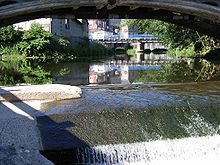This is an old revision of this page, as edited by Ghirlandajo (talk | contribs) at 13:56, 5 May 2024 (→Navigation: An Inland Voyage). The present address (URL) is a permanent link to this revision, which may differ significantly from the current revision.
Revision as of 13:56, 5 May 2024 by Ghirlandajo (talk | contribs) (→Navigation: An Inland Voyage)(diff) ← Previous revision | Latest revision (diff) | Newer revision → (diff) River in Belgium and France| Oise | |
|---|---|
 Boats on the Oise, Charles-François Daubigny, 1865 Boats on the Oise, Charles-François Daubigny, 1865 | |
 | |
| Location | |
| Countries | France and Belgium |
| Physical characteristics | |
| Source | |
| • location | Hainaut |
| • elevation | 309 m (1,014 ft) |
| Mouth | |
| • location | Seine |
| • coordinates | 48°59′12″N 2°4′17″E / 48.98667°N 2.07139°E / 48.98667; 2.07139 |
| Length | 341 km (212 mi) |
| Basin size | 17,000 km (6,600 sq mi) |
| Discharge | |
| • average | 110 m/s (3,900 cu ft/s) |
| Basin features | |
| Progression | Seine→ English Channel |
The Oise (/wɑːz/ WAHZ; Template:IPA-fr) is a river of Belgium and France, flowing for 341 km (212 mi) from its source in the Belgian province of Hainaut, south of Chimay. It crosses the border with France after about 20 km (12 mi). It flows into the Seine at Conflans-Sainte-Honorine, a north-western suburb of Paris. Its main tributary is the Aisne. It gave its name to the French departments of Oise and Val-d'Oise.
Places along the river
In France, the Oise flows through the following départements and towns:
- Aisne: Hirson, Guise, Chauny
- Oise (named after the river): Noyon, Compiègne, Creil
- Val-d'Oise (named after the river): Auvers-sur-Oise, Pontoise, Cergy, Jouy-le-Moutier
- Yvelines: Conflans-Sainte-Honorine
Navigation
Over the past few centuries, the Oise has played an important role as an inland shipping waterway connecting the Seine (and thus Paris) with the coastal regions of northern France, Belgium, and the Netherlands. Robert Louis Stevenson described his canoeing trip on the Oise in his first published book, An Inland Voyage.
With the projected construction of the Seine-Nord Europe Canal, a high-capacity water transport system currently in development, the Oise will be linked at Janville, north of Compiègne, with the high-capacity Canal Dunkerque-Escaut, east of Arleux. The Seine-Nord Europe Canal will replace the old Canal de Saint-Quentin and the current Canal du Nord, the capacity of which is far below standard. When the new Seine-Nord connection is complete, it will allow large vessels to transport goods from the Seine, and thus Paris and its surrounding area, to the ports of Dunkirk, Antwerp and Rotterdam.
Part of the overall project consists of upgrading the river Oise itself between Creil and Compiègne, a project called MAGEO (Mise au gabarit européen de l'Oise) that was put out to public consultation in 2013. Some bends need to be eased and bridges raised to meet the requirements of a class Vb inland waterway.
Tributaries

Tributaries include
Right bank
- Noirieu
- Divette
- Mas or Matz
- Aronde
- Brèche
- Thérain
Left bank
See also
References
- Sandre. "Fiche cours d'eau (H---0100)".
- "MAGEO - Mise au gabarit européen de l'Oise entre Creil et Compiègne".
External links
- River Oise and Canal latéral à l'Oise maps and information, on places, ports and moorings on the canal, by the author of Inland Waterways of France, Imray
- Navigation details for 80 French rivers and canals (French waterways website section)
- Tributaries of the Seine
- Oise basin
- International rivers of Europe
- Rivers of Belgium
- Rivers of France
- Rivers of Aisne
- Rivers of Oise
- Rivers of Val-d'Oise
- Rivers of Yvelines
- Rivers of Hauts-de-France
- Rivers of Île-de-France
- Rivers of Hainaut (province)
- Rivers of the Ardennes (Belgium)
- Rivers of the Ardennes (France)
- Chimay